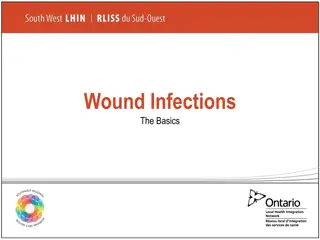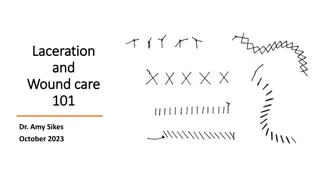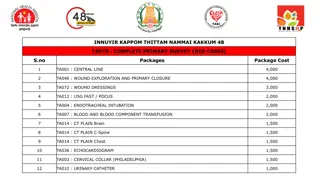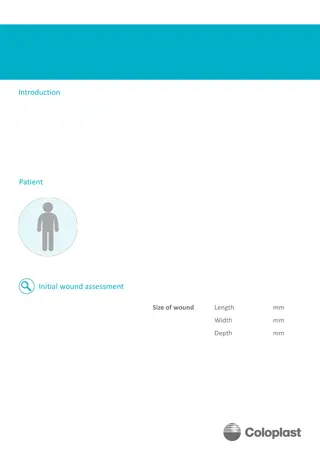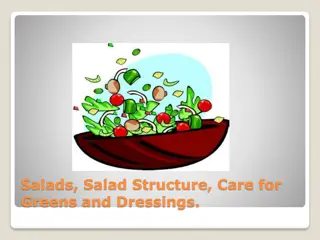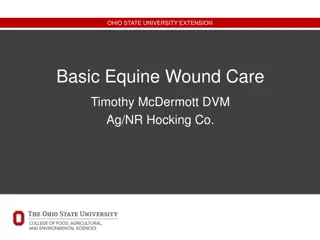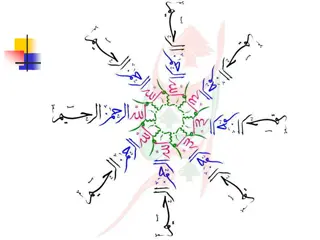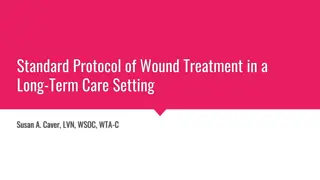Comprehensive Guide to Wound Care: Types, Dressings, and Practices
Understanding wound care is crucial for proper healing. This guide covers types of wounds, purposes of wound dressing, different dressing types, and helpful practice guidelines. Learn about intentional and unintentional wounds, dressing purposes like protection and absorption, and types of dressings such as gauze, transparent, and hydrocolloid. Enhance your knowledge on wound management for optimal healing outcomes.
Download Presentation

Please find below an Image/Link to download the presentation.
The content on the website is provided AS IS for your information and personal use only. It may not be sold, licensed, or shared on other websites without obtaining consent from the author. Download presentation by click this link. If you encounter any issues during the download, it is possible that the publisher has removed the file from their server.
E N D
Presentation Transcript
WOUND CARE Prepared by: Dr. Irene Roco
Outline Outline Definition , types of Wound Purposes of Wound Dressing Types of Wound dressing Practice Guidelines Things to remember
Wound Wound an injury to living tissue caused by a cut, blow, or other impact, typically one in which the skin is cut or broken. Types of Wounds: A Intentional therapeutic 1. Surgical operations 2. Venipuncture B Unintentional accidental; caused by trauma 1. Open skin or mucous membranes surface is broken 2. closed tissues are traumatized without a break in the skin
Purposes of Wound Dressing Purposes of Wound Dressing 1. Protect wound from mechanical injury and microbial contamination 2. Provide or maintain moist wound healing 3. Provide thermal insulation 4. Absorb drainage or debride a wound 5. Prevent hemorrhage 6. Holding medication in place
Types of Wound Dressing Types of Wound Dressing Types and sizes of dressing differ depends on: Location, size and type of wound amount of exudate Whether the wound requires debridement or is infected Frequency of dressing change, ease or difficulty of dressing application and cost 1. Gauze dressing: highly absorbent nature makes them ideal for covering fresh wound (bleeding)
2. Transparent dressing: (OP-Site) allow to assess wounds including ulcerated or burned skin areas. Commonly are used to cover peripheral ¢ral IV. Advantages: Act as temporary skin Non porous, non absorbent; self adhesive, does not require changing; often left in place until healing has occurred or as long as it remains intact Wound can be assessed Wound remains moist Can be placed over a joint because it is elastic Adhere only to the skin around the wound, not on the wound itself Client can shower or bath without removing the dressing
3. Hydrocolloid dressing: (DuoDerm) air-and water-occlusive coverings; used over pressure ulcer. Keep wound moist which is help in healing process. May left for 1week. Advantages: Limitations Lasts 3-7 days Occlusive, opaque, obscure wound visibility Water resistant; don t need a cover Limited absorption capacity Act as temporary skin Can be molded to uneven skin Can facilitate aerobic microbial growth Decrease pain reducing the need for analgesics Can soften and wrinkle the edges with wear and tear movement Difficult to remove and may leave a residue on the skin Should not be used for infected wounds or those with deep tracts or fistulas
Practice Guidelines Practice Guidelines 1. Follow standard precautions for personal protection. 2. Use solutions (isotonic saline, wound cleanser) to clean or irrigate wounds 3. Use gauze squares. Avoid using cotton balls and other products that shed fibers onto the wound surface 4. To retain wound moisture, avoid drying a wound after cleaning it 5. Hold cleaning sponges with forceps or with a sterile gloved hands 6. Clean the wound in an outward direction 7. Consider not cleaning the wound at all if it appears to be clean
Things to remember Things to remember Keep unused dressings in the original package or other closed plastic package Store dressings in a clean, dry place Throw out the entire package if any dressings get wet, contaminated, or dirty Place soiled gloves and wrappers in disposal bag, tie or seal the bag, and discard Clean scissors and forceps with alcohol before and after each use
http://www.utahmountainbiking.com/firstaid/images/pics-firstaid/bf-drss5.jpghttp://www.utahmountainbiking.com/firstaid/images/pics-firstaid/bf-drss5.jpg http://image.made-in-china.com/2f0j00tMiaudTPbwcs/Transparent-and-Waterproof-Dressing-F2071-F2072-.jpg L E T S R E V I E W http://image.made-in-china.com/2f0j00hBSQKtocCkbr/Bordered-Gauze-Wound-Dressing.jpg http://jan.ucc.nau.edu/~daa/woundproducts/duoderm.jpg









